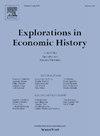探索美国商品市场一体化200年:一种结构时间序列模型方法
IF 2.6
1区 历史学
Q1 ECONOMICS
引用次数: 0
摘要
本文使用一个结构时间序列模型来探索1750-1949年美国商品市场的收敛性、效率和跨期平滑。我发现,在最易腐烂的商品中,几乎持续的趋同主要集中在前沿,南北战争前的广泛效率提高,以及从19世纪80年代开始的跨期平滑。结果揭示了所有三个指标的新的整合时期,并强调了前沿的快速整合。本文章由计算机程序翻译,如有差异,请以英文原文为准。
Exploring 200 years of U.S. commodity market integration: A structural time series model approach
This paper uses a structural time series model to explore U.S. commodity market convergence, efficiency, and intertemporal smoothing from 1750–1949. I find near-continuous convergence that is largely concentrated in the frontier, broad antebellum efficiency gains, and intertemporal smoothing from the 1880s onward among the most perishable goods. The results reveal new periods of integration across all three metrics and underscore the rapid rate of integration on the frontier.
求助全文
通过发布文献求助,成功后即可免费获取论文全文。
去求助
来源期刊

Explorations in Economic History
Multiple-
CiteScore
2.50
自引率
8.70%
发文量
27
期刊介绍:
Explorations in Economic History provides broad coverage of the application of economic analysis to historical episodes. The journal has a tradition of innovative applications of theory and quantitative techniques, and it explores all aspects of economic change, all historical periods, all geographical locations, and all political and social systems. The journal includes papers by economists, economic historians, demographers, geographers, and sociologists. Explorations in Economic History is the only journal where you will find "Essays in Exploration." This unique department alerts economic historians to the potential in a new area of research, surveying the recent literature and then identifying the most promising issues to pursue.
 求助内容:
求助内容: 应助结果提醒方式:
应助结果提醒方式:


